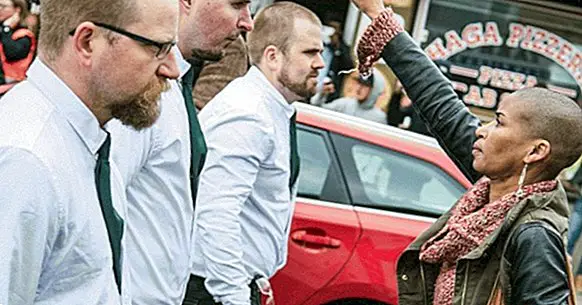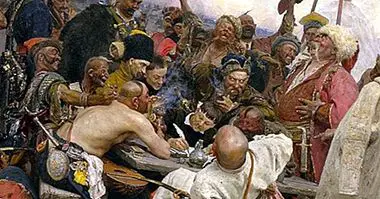What is social violence?
We live in an increasingly globalized society that allows more or less frequent knowledge and contact with people with different opinions, beliefs and ways of seeing the world. Although this generally generates a current of understanding between different cultures, sometimes it can degenerate into social violence .
And is that contact with different schools of thought allows an evolution of society towards values such as tolerance and mutual respect, but for some people it can be aversive to perceive the differences between ways of living and thinking with other peoples and groups, being in some cases in direct opposition to one's beliefs and assuming the perception of an inequality or the loss of social power. Thus, the loss of power and the lack of understanding of other ways of seeing the world, considering one's ideals as the only or the most appropriate, can degenerate into violence.
- Related article: "The 11 types of violence (and the different kinds of aggression)"
Social violence: what is it?
Social violence is understood as all that act with social impact that attends to physical, psychological or relational integrity of a person or a collective, said acts being carried out by a subject or by the community itself.
In some cases this violence is applied with the purpose of achieving an improvement in living conditions or as a form of protest for a treatment that is considered as humiliating, as in some riots and riots. On other occasions it is intended to diminish the power of others in order to harm them or their points of view, or to increase the perception of one's own authority.
But in general, we can determine that the objective of social violence as such is obtaining or maintaining power and social status . However, in many cases this is linked to political violence, in which violent acts are carried out with the aim of achieving political power or economic violence, in which the objective is to obtain capital.
Types of social violence
There are multiple forms of social violence, some of which are domestic violence, racist and / or homophobic attacks, terrorist attacks, kidnappings, murders or homicides, sexual assaults, vandalism, school or work harassment or any type of violence. action that seeks to alter public order through the exercise of violence.
However, this type of violence does not cover only criminal acts carried out directly , but also include aspects such as values, stereotypes, prejudices and slander transmitted culturally or through means that may incite hatred or disparagement to a person or group. Clear examples of this are the promulgation and expansion of beliefs that incite machismo, homophobia or racism.
Associated factors
The social violence can originate in very different and diverse contexts, being incited by the interaction of a great amount of variables. Thus, there is no single cause of social violence but rather it has a multiple origin , needing an investigation of the different factors that can end up leading to it. Some of these factors are the following
1. Perception of inequality
On many occasions, social violence is exercised in conditions in which individuals they perceive the existence of inequality .
The observation or belief that other people who in principle should receive the same treatment as the subject themselves receive favorable treatment from the institutions or societies, or even more important than the person or group itself receives unfair treatment or worse treatment. that should generate a comparative grievance that can end in some type of violence. Inequality perception may be behind mass phenomena such as riots and riots.
2. Threat to one's position
As we have said, the objective of social violence is to maintain or increase one's status or social power. One of the main reasons for this is the consideration that the power itself is threatened. The exercise of power by others can be considered as incompatible with autonomy and own power , with which the individual or group is frustrated and seeks to increase their own control of others through violence.
On the other hand, the idea that there is an entity external to society that puts its stability at risk is often used as an excuse to undertake aggressive measures to control the population, something for which a clear justification is needed. In order to avoid this danger, the welfare of minorities can be compromised.
3. Social exclusion
Although it is linked to the above factors, social exclusion is in itself an important factor when explaining some acts of social violence. The feeling of not be considered by the whole of society as part of it It generates frustration and anger with respect to the world and the society in which one lives. Vandalism, robbery and aggression are some of the types of violence that are usually generated by this factor.
- Related article: "The 16 types of discrimination (and their causes)"
4. Rigid and restrictive education
Educational patterns are very important when explaining social violence. An excessively rigid and restrictive education can cause the person to be Unable to flex their views, opinions and beliefs . This encourages us to think that the way of doing to which the subject is accustomed is the only or the most valid, being other inconsistent and unacceptable options.
For example, identity politics, based on the disparagement of what is different, can be based on an education based on Manichaeism and the demonization of people who are perceived as alien to the group to which they belong.
Vulnerable groups or frequent targets of social violence
As a general rule, social violence is often applied against minorities, especially those that have traditionally been persecuted or oppressed but have, over time, increased their social acceptance, power and rights.
Such change is perceived by some individuals as a threat to their own power and beliefs, trying perpetuate traditional roles through direct or indirect violence . However, in other cases, it is the minority that goes on to exercise violence, as a form of protest or vindication or in order to achieve a specific goal, as occurs in some popular revolts.
Likewise, in some cases other collectives are targets of indirect social violence in order to be used as means to perpetuate one's own power, transforming them into originally neutral individuals or even the very person who is the object of violence in a transmitter of said violence. Let's see some of the groups that are either particularly vulnerable or have been subject to social violence throughout history.
1. Childhood
One of the most vulnerable groups in the face of social violence, whether it occurs directly on it or on the contrary observes it indirectly, is that of childhood. Children are especially vulnerable, considering that they are immersed in a development process that has not yet provided them with enough neither physical nor psychic tools to deal with violent situations efficiently.
As a general rule, social violence against children usually aims to dominate a more vulnerable person in order to increase their own perception of power, or as an indirect means to harm a person or institution.
Likewise, the continued observation of violence as a method of control can provoke thinking and the belief that attack is an adequate and adaptive strategy to achieve one's goals.
2. Disabled
People with disabilities, both physical and intellectual, can also be subject to social violence, not allow them to participate in society or to exercise different types of action on them as a form of domination and exercise of power.
- Maybe you're interested: "Capacitism: discrimination against functional diversity"
3. Popular classes
The popular classes and the population with less purchasing power it is often subject to social and institutional violence, taking advantage of its precarious and unstable situation. The same happens in groups with a high risk of social exclusion, as people protected by the state or drug addicts.
4. Women
The role of women in society has been changing throughout history, reaching in recent times to seek equality between the sexes. However, some individuals and sectors of society resist the existence of equality, which in many cases supposes a loss of power and the traditional role assigned to man.
Some examples of social violence on this group are gender violence , the forced perpetuation of traditional roles, the difficulties of access to the workplace or the inequalities still present.
5. Immigration, ethnic and religious minorities
Another classic objective of social violence is ethnic and / or religious minorities. Although in this aspect too the general society seeks equality between people of different ethnicities and cultures, some sectors do not welcome the incorporation into the community of individuals with characteristics that do not coincide with the most usual. The most frequent type of social violence is the linked to racism , which can include physical aggressions, humiliations and even attacks.
- Related article: "The 8 most common types of racism"
6. LGBT community
The LGTB community is another of the collectives that traditionally has been persecuted, vexed and undervalued . With the passage of time this group is seeing how it is increasingly accepted in the community, gradually achieving equal rights with respect to the heterosexual population.However, just as it happens with equality between the sexes and between races, some individuals and sectors of society consider that equality of rights should not occur, exercising different types of physical, psychological or social violence against this group.
- Maybe you're interested: "Anti-gay therapy: that's how you tried to" cure "homosexuality"
Effects of social violence
The effects of social violence, as well as its causes, can be multiple and varied.
The person, group or institution attacked can suffer a deep sense of humiliation that can greatly diminish their self-esteem and autonomy, and even cause the death of the violated party.
In some cases the aggrieved entity can be forced or coerced into performing certain behaviors for fear of the consequences of the opposition or because of a change of attitude after the experience of the violent episode. In others, the deployment of violence may awaken the aggressor's reactivity and increase his determination to pursue his ideals or to maintain his position despite the risks.
In the same way, knowledge and observation of violent behavior can awaken an effect called and unleash new attacks. In other cases, it can, as with children, teach them that violence is a useful mechanism to achieve their own goals.
One of the risks of social violence is that it is often minimized, through mechanisms such as habituation, desensitization, invisibilization and normalization . These mechanisms cause that in the long run the population is not concerned about the commission of violent acts (for example, we are accustomed to receiving news of aggressions, violence or casualties in other countries due to wars and natural disasters, to the point that we have desensitized and we do not usually do anything about it).
In order to avoid the repetition of violent acts, it is necessary to recognize and fight against the mechanisms that elicit it, such as those mentioned above, and to ensure that such acts of violence are not covered or hidden, but recognized and combated.
Bibliographic references:
- Corsi, J. and Peyru, G.M. (2003). Social violence. Ariel



















